Critical Evaluation of Dynamic Capabilities at Tesco Plc: A Report
VerifiedAdded on 2023/01/11
|11
|3775
|45
Report
AI Summary
This report provides a comprehensive analysis of Tesco Plc's dynamic capabilities, exploring how the company manages innovation and technology transfer to maintain a competitive advantage. The introduction establishes the context of managing innovation and highlights Tesco as a case study. The main body delves into building and managing dynamic capabilities, including the application of digital transformation, and evaluates the methodology of the analytical approach. It examines Tesco's strategies such as the implementation of online grocery shopping, click and collect services, in-store digitalization, and the development of the Clubcard loyalty program. The report critically evaluates these initiatives, assessing their impact on customer experience, cost reduction, and fraud prevention. The findings demonstrate how Tesco leverages data analysis, technology, and strategic partnerships to adapt to market changes and enhance its business model. The conclusion summarizes the key insights and emphasizes the importance of dynamic capabilities in the modern business environment. The report references various academic sources to support its analysis.

Paraphrase This Document
Need a fresh take? Get an instant paraphrase of this document with our AI Paraphraser
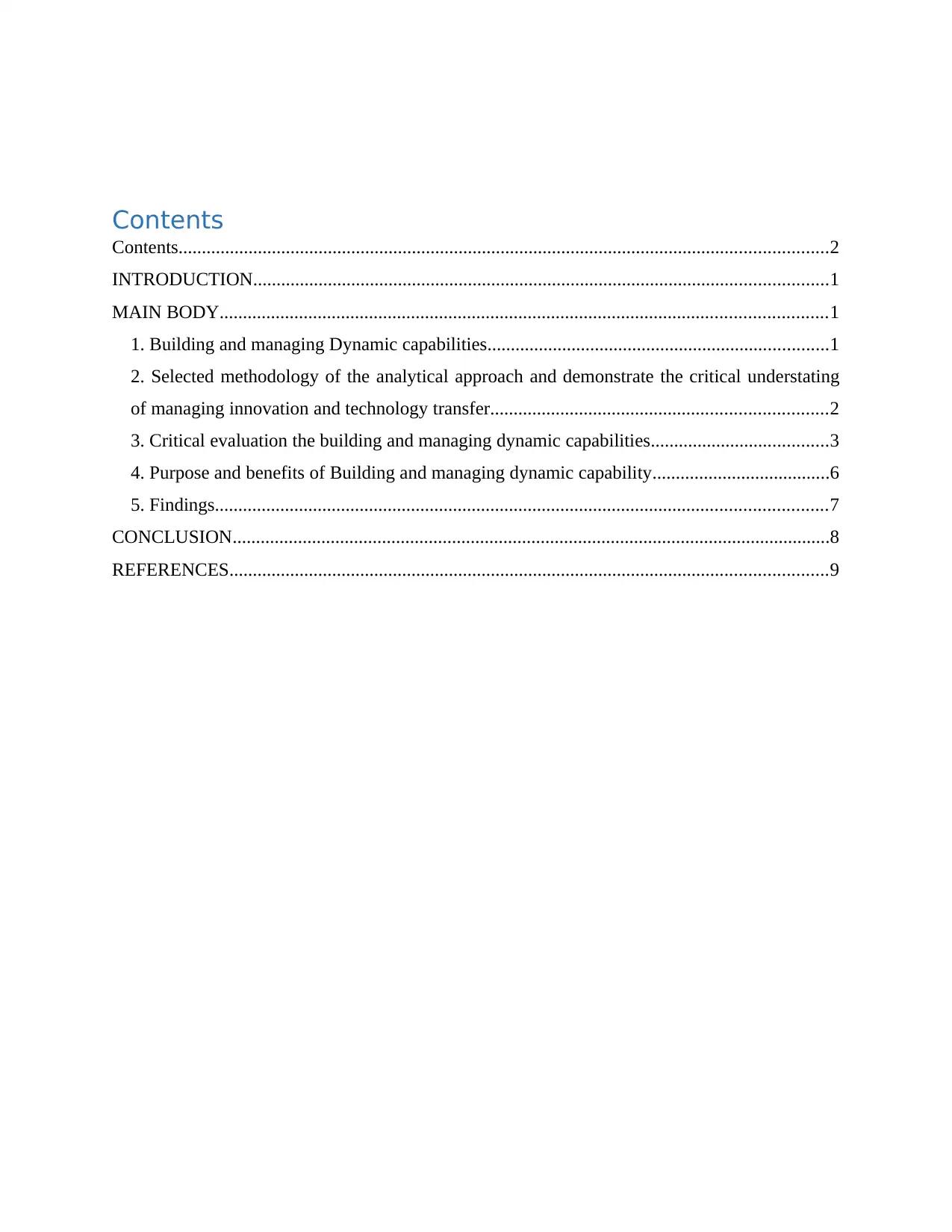
Contents
Contents...........................................................................................................................................2
INTRODUCTION...........................................................................................................................1
MAIN BODY..................................................................................................................................1
1. Building and managing Dynamic capabilities.........................................................................1
2. Selected methodology of the analytical approach and demonstrate the critical understating
of managing innovation and technology transfer........................................................................2
3. Critical evaluation the building and managing dynamic capabilities......................................3
4. Purpose and benefits of Building and managing dynamic capability......................................6
5. Findings...................................................................................................................................7
CONCLUSION................................................................................................................................8
REFERENCES................................................................................................................................9
Contents...........................................................................................................................................2
INTRODUCTION...........................................................................................................................1
MAIN BODY..................................................................................................................................1
1. Building and managing Dynamic capabilities.........................................................................1
2. Selected methodology of the analytical approach and demonstrate the critical understating
of managing innovation and technology transfer........................................................................2
3. Critical evaluation the building and managing dynamic capabilities......................................3
4. Purpose and benefits of Building and managing dynamic capability......................................6
5. Findings...................................................................................................................................7
CONCLUSION................................................................................................................................8
REFERENCES................................................................................................................................9
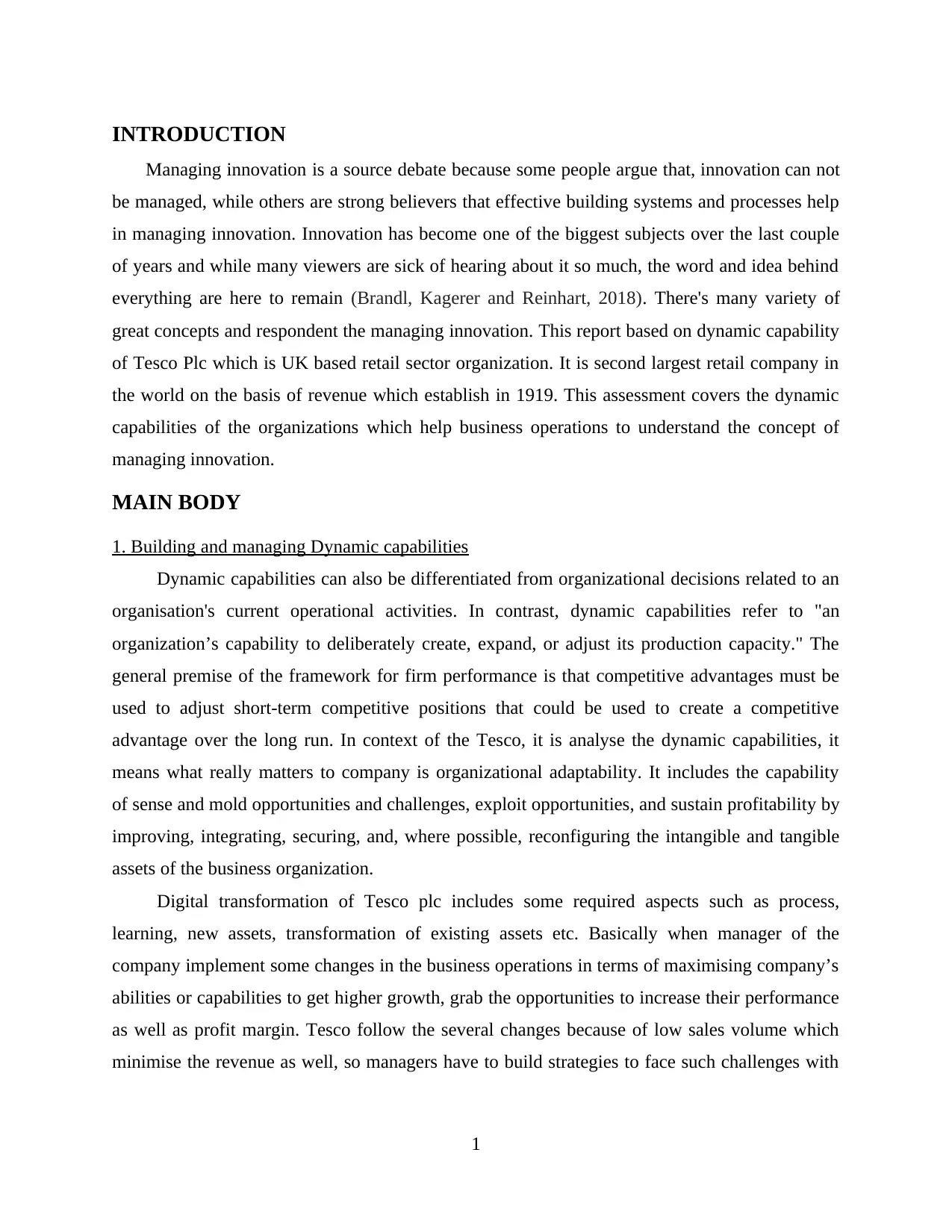
INTRODUCTION
Managing innovation is a source debate because some people argue that, innovation can not
be managed, while others are strong believers that effective building systems and processes help
in managing innovation. Innovation has become one of the biggest subjects over the last couple
of years and while many viewers are sick of hearing about it so much, the word and idea behind
everything are here to remain (Brandl, Kagerer and Reinhart, 2018). There's many variety of
great concepts and respondent the managing innovation. This report based on dynamic capability
of Tesco Plc which is UK based retail sector organization. It is second largest retail company in
the world on the basis of revenue which establish in 1919. This assessment covers the dynamic
capabilities of the organizations which help business operations to understand the concept of
managing innovation.
MAIN BODY
1. Building and managing Dynamic capabilities
Dynamic capabilities can also be differentiated from organizational decisions related to an
organisation's current operational activities. In contrast, dynamic capabilities refer to "an
organization’s capability to deliberately create, expand, or adjust its production capacity." The
general premise of the framework for firm performance is that competitive advantages must be
used to adjust short-term competitive positions that could be used to create a competitive
advantage over the long run. In context of the Tesco, it is analyse the dynamic capabilities, it
means what really matters to company is organizational adaptability. It includes the capability
of sense and mold opportunities and challenges, exploit opportunities, and sustain profitability by
improving, integrating, securing, and, where possible, reconfiguring the intangible and tangible
assets of the business organization.
Digital transformation of Tesco plc includes some required aspects such as process,
learning, new assets, transformation of existing assets etc. Basically when manager of the
company implement some changes in the business operations in terms of maximising company’s
abilities or capabilities to get higher growth, grab the opportunities to increase their performance
as well as profit margin. Tesco follow the several changes because of low sales volume which
minimise the revenue as well, so managers have to build strategies to face such challenges with
1
Managing innovation is a source debate because some people argue that, innovation can not
be managed, while others are strong believers that effective building systems and processes help
in managing innovation. Innovation has become one of the biggest subjects over the last couple
of years and while many viewers are sick of hearing about it so much, the word and idea behind
everything are here to remain (Brandl, Kagerer and Reinhart, 2018). There's many variety of
great concepts and respondent the managing innovation. This report based on dynamic capability
of Tesco Plc which is UK based retail sector organization. It is second largest retail company in
the world on the basis of revenue which establish in 1919. This assessment covers the dynamic
capabilities of the organizations which help business operations to understand the concept of
managing innovation.
MAIN BODY
1. Building and managing Dynamic capabilities
Dynamic capabilities can also be differentiated from organizational decisions related to an
organisation's current operational activities. In contrast, dynamic capabilities refer to "an
organization’s capability to deliberately create, expand, or adjust its production capacity." The
general premise of the framework for firm performance is that competitive advantages must be
used to adjust short-term competitive positions that could be used to create a competitive
advantage over the long run. In context of the Tesco, it is analyse the dynamic capabilities, it
means what really matters to company is organizational adaptability. It includes the capability
of sense and mold opportunities and challenges, exploit opportunities, and sustain profitability by
improving, integrating, securing, and, where possible, reconfiguring the intangible and tangible
assets of the business organization.
Digital transformation of Tesco plc includes some required aspects such as process,
learning, new assets, transformation of existing assets etc. Basically when manager of the
company implement some changes in the business operations in terms of maximising company’s
abilities or capabilities to get higher growth, grab the opportunities to increase their performance
as well as profit margin. Tesco follow the several changes because of low sales volume which
minimise the revenue as well, so managers have to build strategies to face such challenges with
1
⊘ This is a preview!⊘
Do you want full access?
Subscribe today to unlock all pages.

Trusted by 1+ million students worldwide
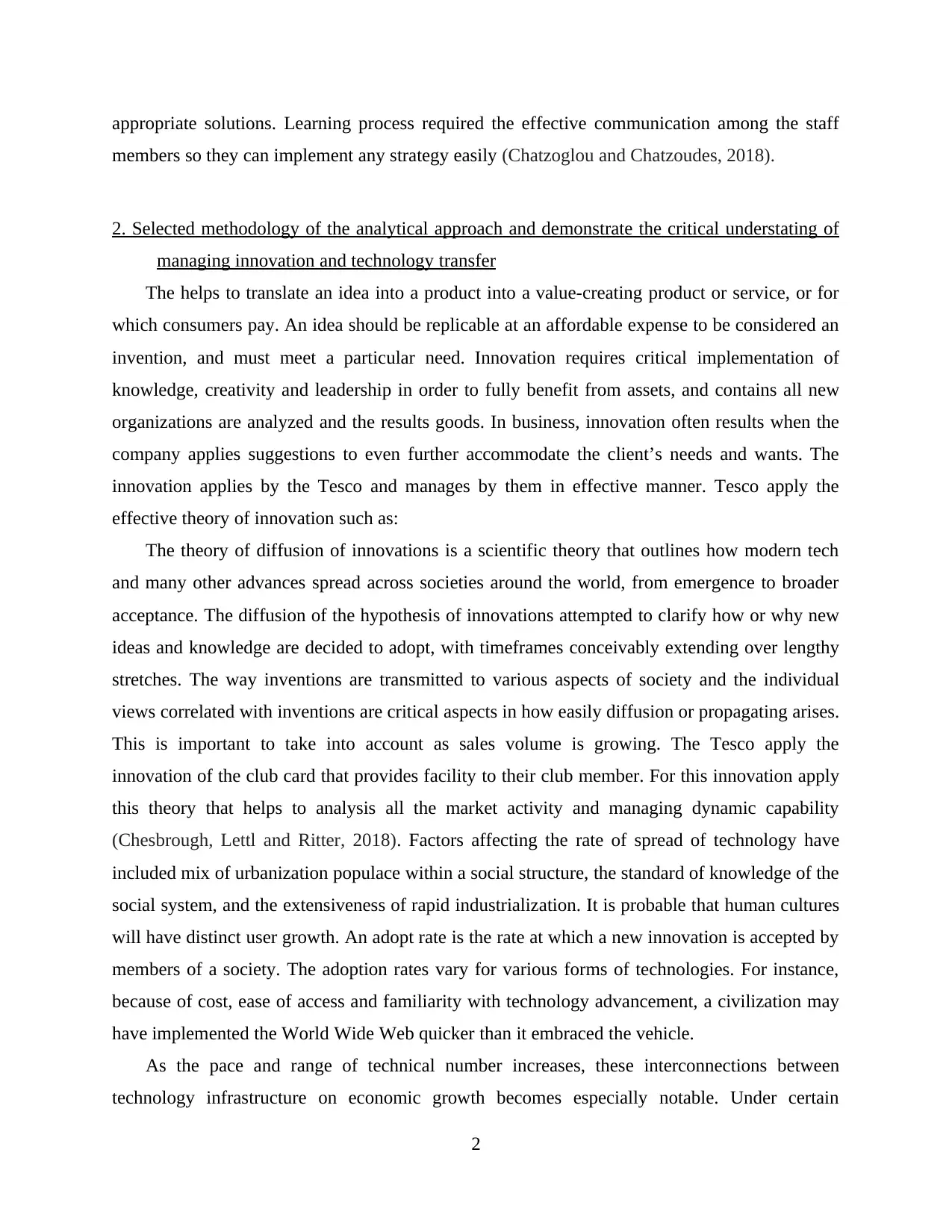
appropriate solutions. Learning process required the effective communication among the staff
members so they can implement any strategy easily (Chatzoglou and Chatzoudes, 2018).
2. Selected methodology of the analytical approach and demonstrate the critical understating of
managing innovation and technology transfer
The helps to translate an idea into a product into a value-creating product or service, or for
which consumers pay. An idea should be replicable at an affordable expense to be considered an
invention, and must meet a particular need. Innovation requires critical implementation of
knowledge, creativity and leadership in order to fully benefit from assets, and contains all new
organizations are analyzed and the results goods. In business, innovation often results when the
company applies suggestions to even further accommodate the client’s needs and wants. The
innovation applies by the Tesco and manages by them in effective manner. Tesco apply the
effective theory of innovation such as:
The theory of diffusion of innovations is a scientific theory that outlines how modern tech
and many other advances spread across societies around the world, from emergence to broader
acceptance. The diffusion of the hypothesis of innovations attempted to clarify how or why new
ideas and knowledge are decided to adopt, with timeframes conceivably extending over lengthy
stretches. The way inventions are transmitted to various aspects of society and the individual
views correlated with inventions are critical aspects in how easily diffusion or propagating arises.
This is important to take into account as sales volume is growing. The Tesco apply the
innovation of the club card that provides facility to their club member. For this innovation apply
this theory that helps to analysis all the market activity and managing dynamic capability
(Chesbrough, Lettl and Ritter, 2018). Factors affecting the rate of spread of technology have
included mix of urbanization populace within a social structure, the standard of knowledge of the
social system, and the extensiveness of rapid industrialization. It is probable that human cultures
will have distinct user growth. An adopt rate is the rate at which a new innovation is accepted by
members of a society. The adoption rates vary for various forms of technologies. For instance,
because of cost, ease of access and familiarity with technology advancement, a civilization may
have implemented the World Wide Web quicker than it embraced the vehicle.
As the pace and range of technical number increases, these interconnections between
technology infrastructure on economic growth becomes especially notable. Under certain
2
members so they can implement any strategy easily (Chatzoglou and Chatzoudes, 2018).
2. Selected methodology of the analytical approach and demonstrate the critical understating of
managing innovation and technology transfer
The helps to translate an idea into a product into a value-creating product or service, or for
which consumers pay. An idea should be replicable at an affordable expense to be considered an
invention, and must meet a particular need. Innovation requires critical implementation of
knowledge, creativity and leadership in order to fully benefit from assets, and contains all new
organizations are analyzed and the results goods. In business, innovation often results when the
company applies suggestions to even further accommodate the client’s needs and wants. The
innovation applies by the Tesco and manages by them in effective manner. Tesco apply the
effective theory of innovation such as:
The theory of diffusion of innovations is a scientific theory that outlines how modern tech
and many other advances spread across societies around the world, from emergence to broader
acceptance. The diffusion of the hypothesis of innovations attempted to clarify how or why new
ideas and knowledge are decided to adopt, with timeframes conceivably extending over lengthy
stretches. The way inventions are transmitted to various aspects of society and the individual
views correlated with inventions are critical aspects in how easily diffusion or propagating arises.
This is important to take into account as sales volume is growing. The Tesco apply the
innovation of the club card that provides facility to their club member. For this innovation apply
this theory that helps to analysis all the market activity and managing dynamic capability
(Chesbrough, Lettl and Ritter, 2018). Factors affecting the rate of spread of technology have
included mix of urbanization populace within a social structure, the standard of knowledge of the
social system, and the extensiveness of rapid industrialization. It is probable that human cultures
will have distinct user growth. An adopt rate is the rate at which a new innovation is accepted by
members of a society. The adoption rates vary for various forms of technologies. For instance,
because of cost, ease of access and familiarity with technology advancement, a civilization may
have implemented the World Wide Web quicker than it embraced the vehicle.
As the pace and range of technical number increases, these interconnections between
technology infrastructure on economic growth becomes especially notable. Under certain
2
Paraphrase This Document
Need a fresh take? Get an instant paraphrase of this document with our AI Paraphraser
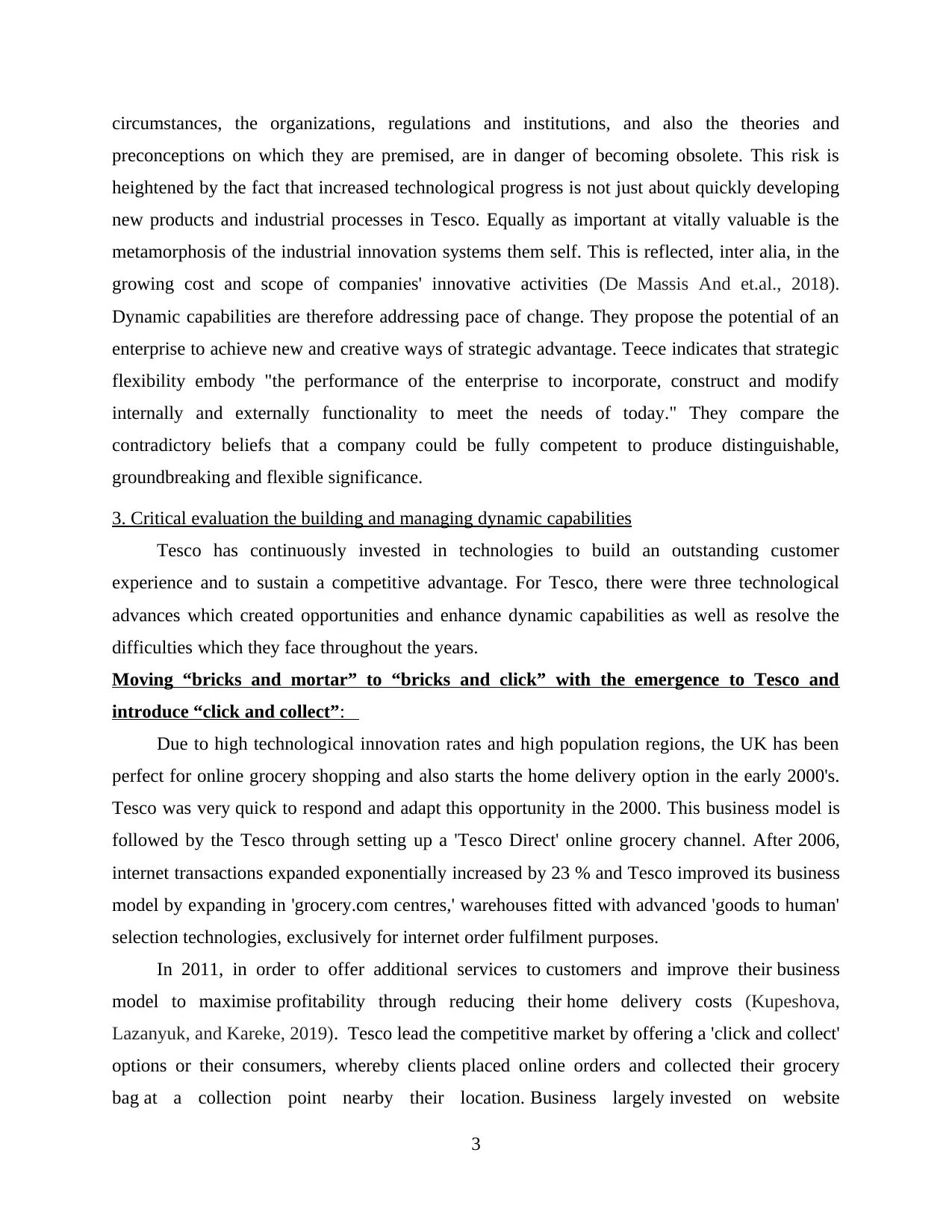
circumstances, the organizations, regulations and institutions, and also the theories and
preconceptions on which they are premised, are in danger of becoming obsolete. This risk is
heightened by the fact that increased technological progress is not just about quickly developing
new products and industrial processes in Tesco. Equally as important at vitally valuable is the
metamorphosis of the industrial innovation systems them self. This is reflected, inter alia, in the
growing cost and scope of companies' innovative activities (De Massis And et.al., 2018).
Dynamic capabilities are therefore addressing pace of change. They propose the potential of an
enterprise to achieve new and creative ways of strategic advantage. Teece indicates that strategic
flexibility embody "the performance of the enterprise to incorporate, construct and modify
internally and externally functionality to meet the needs of today." They compare the
contradictory beliefs that a company could be fully competent to produce distinguishable,
groundbreaking and flexible significance.
3. Critical evaluation the building and managing dynamic capabilities
Tesco has continuously invested in technologies to build an outstanding customer
experience and to sustain a competitive advantage. For Tesco, there were three technological
advances which created opportunities and enhance dynamic capabilities as well as resolve the
difficulties which they face throughout the years.
Moving “bricks and mortar” to “bricks and click” with the emergence to Tesco and
introduce “click and collect”:
Due to high technological innovation rates and high population regions, the UK has been
perfect for online grocery shopping and also starts the home delivery option in the early 2000's.
Tesco was very quick to respond and adapt this opportunity in the 2000. This business model is
followed by the Tesco through setting up a 'Tesco Direct' online grocery channel. After 2006,
internet transactions expanded exponentially increased by 23 % and Tesco improved its business
model by expanding in 'grocery.com centres,' warehouses fitted with advanced 'goods to human'
selection technologies, exclusively for internet order fulfilment purposes.
In 2011, in order to offer additional services to customers and improve their business
model to maximise profitability through reducing their home delivery costs (Kupeshova,
Lazanyuk, and Kareke, 2019). Tesco lead the competitive market by offering a 'click and collect'
options or their consumers, whereby clients placed online orders and collected their grocery
bag at a collection point nearby their location. Business largely invested on website
3
preconceptions on which they are premised, are in danger of becoming obsolete. This risk is
heightened by the fact that increased technological progress is not just about quickly developing
new products and industrial processes in Tesco. Equally as important at vitally valuable is the
metamorphosis of the industrial innovation systems them self. This is reflected, inter alia, in the
growing cost and scope of companies' innovative activities (De Massis And et.al., 2018).
Dynamic capabilities are therefore addressing pace of change. They propose the potential of an
enterprise to achieve new and creative ways of strategic advantage. Teece indicates that strategic
flexibility embody "the performance of the enterprise to incorporate, construct and modify
internally and externally functionality to meet the needs of today." They compare the
contradictory beliefs that a company could be fully competent to produce distinguishable,
groundbreaking and flexible significance.
3. Critical evaluation the building and managing dynamic capabilities
Tesco has continuously invested in technologies to build an outstanding customer
experience and to sustain a competitive advantage. For Tesco, there were three technological
advances which created opportunities and enhance dynamic capabilities as well as resolve the
difficulties which they face throughout the years.
Moving “bricks and mortar” to “bricks and click” with the emergence to Tesco and
introduce “click and collect”:
Due to high technological innovation rates and high population regions, the UK has been
perfect for online grocery shopping and also starts the home delivery option in the early 2000's.
Tesco was very quick to respond and adapt this opportunity in the 2000. This business model is
followed by the Tesco through setting up a 'Tesco Direct' online grocery channel. After 2006,
internet transactions expanded exponentially increased by 23 % and Tesco improved its business
model by expanding in 'grocery.com centres,' warehouses fitted with advanced 'goods to human'
selection technologies, exclusively for internet order fulfilment purposes.
In 2011, in order to offer additional services to customers and improve their business
model to maximise profitability through reducing their home delivery costs (Kupeshova,
Lazanyuk, and Kareke, 2019). Tesco lead the competitive market by offering a 'click and collect'
options or their consumers, whereby clients placed online orders and collected their grocery
bag at a collection point nearby their location. Business largely invested on website
3
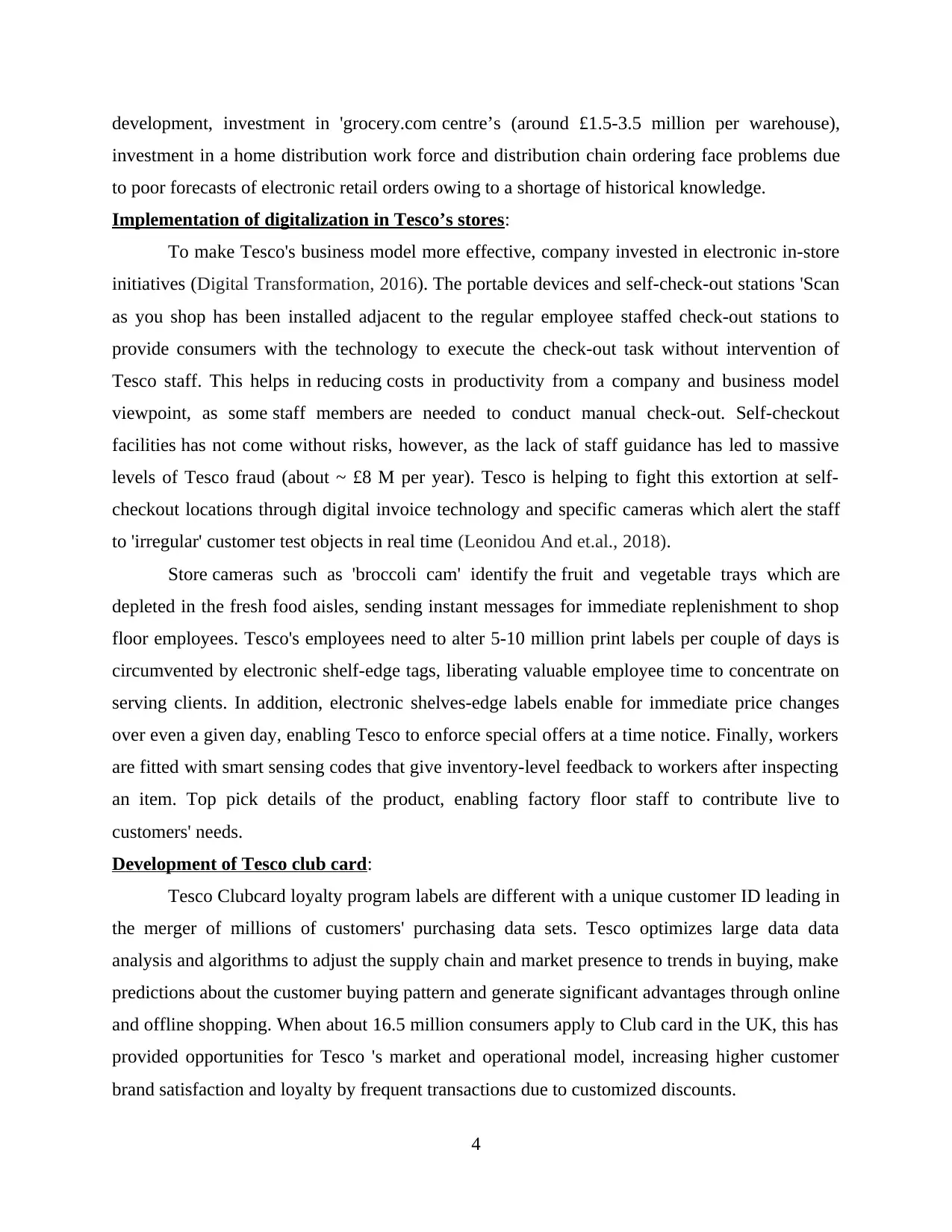
development, investment in 'grocery.com centre’s (around £1.5-3.5 million per warehouse),
investment in a home distribution work force and distribution chain ordering face problems due
to poor forecasts of electronic retail orders owing to a shortage of historical knowledge.
Implementation of digitalization in Tesco’s stores:
To make Tesco's business model more effective, company invested in electronic in-store
initiatives (Digital Transformation, 2016). The portable devices and self-check-out stations 'Scan
as you shop has been installed adjacent to the regular employee staffed check-out stations to
provide consumers with the technology to execute the check-out task without intervention of
Tesco staff. This helps in reducing costs in productivity from a company and business model
viewpoint, as some staff members are needed to conduct manual check-out. Self-checkout
facilities has not come without risks, however, as the lack of staff guidance has led to massive
levels of Tesco fraud (about ~ £8 M per year). Tesco is helping to fight this extortion at self-
checkout locations through digital invoice technology and specific cameras which alert the staff
to 'irregular' customer test objects in real time (Leonidou And et.al., 2018).
Store cameras such as 'broccoli cam' identify the fruit and vegetable trays which are
depleted in the fresh food aisles, sending instant messages for immediate replenishment to shop
floor employees. Tesco's employees need to alter 5-10 million print labels per couple of days is
circumvented by electronic shelf-edge tags, liberating valuable employee time to concentrate on
serving clients. In addition, electronic shelves-edge labels enable for immediate price changes
over even a given day, enabling Tesco to enforce special offers at a time notice. Finally, workers
are fitted with smart sensing codes that give inventory-level feedback to workers after inspecting
an item. Top pick details of the product, enabling factory floor staff to contribute live to
customers' needs.
Development of Tesco club card:
Tesco Clubcard loyalty program labels are different with a unique customer ID leading in
the merger of millions of customers' purchasing data sets. Tesco optimizes large data data
analysis and algorithms to adjust the supply chain and market presence to trends in buying, make
predictions about the customer buying pattern and generate significant advantages through online
and offline shopping. When about 16.5 million consumers apply to Club card in the UK, this has
provided opportunities for Tesco 's market and operational model, increasing higher customer
brand satisfaction and loyalty by frequent transactions due to customized discounts.
4
investment in a home distribution work force and distribution chain ordering face problems due
to poor forecasts of electronic retail orders owing to a shortage of historical knowledge.
Implementation of digitalization in Tesco’s stores:
To make Tesco's business model more effective, company invested in electronic in-store
initiatives (Digital Transformation, 2016). The portable devices and self-check-out stations 'Scan
as you shop has been installed adjacent to the regular employee staffed check-out stations to
provide consumers with the technology to execute the check-out task without intervention of
Tesco staff. This helps in reducing costs in productivity from a company and business model
viewpoint, as some staff members are needed to conduct manual check-out. Self-checkout
facilities has not come without risks, however, as the lack of staff guidance has led to massive
levels of Tesco fraud (about ~ £8 M per year). Tesco is helping to fight this extortion at self-
checkout locations through digital invoice technology and specific cameras which alert the staff
to 'irregular' customer test objects in real time (Leonidou And et.al., 2018).
Store cameras such as 'broccoli cam' identify the fruit and vegetable trays which are
depleted in the fresh food aisles, sending instant messages for immediate replenishment to shop
floor employees. Tesco's employees need to alter 5-10 million print labels per couple of days is
circumvented by electronic shelf-edge tags, liberating valuable employee time to concentrate on
serving clients. In addition, electronic shelves-edge labels enable for immediate price changes
over even a given day, enabling Tesco to enforce special offers at a time notice. Finally, workers
are fitted with smart sensing codes that give inventory-level feedback to workers after inspecting
an item. Top pick details of the product, enabling factory floor staff to contribute live to
customers' needs.
Development of Tesco club card:
Tesco Clubcard loyalty program labels are different with a unique customer ID leading in
the merger of millions of customers' purchasing data sets. Tesco optimizes large data data
analysis and algorithms to adjust the supply chain and market presence to trends in buying, make
predictions about the customer buying pattern and generate significant advantages through online
and offline shopping. When about 16.5 million consumers apply to Club card in the UK, this has
provided opportunities for Tesco 's market and operational model, increasing higher customer
brand satisfaction and loyalty by frequent transactions due to customized discounts.
4
⊘ This is a preview!⊘
Do you want full access?
Subscribe today to unlock all pages.

Trusted by 1+ million students worldwide
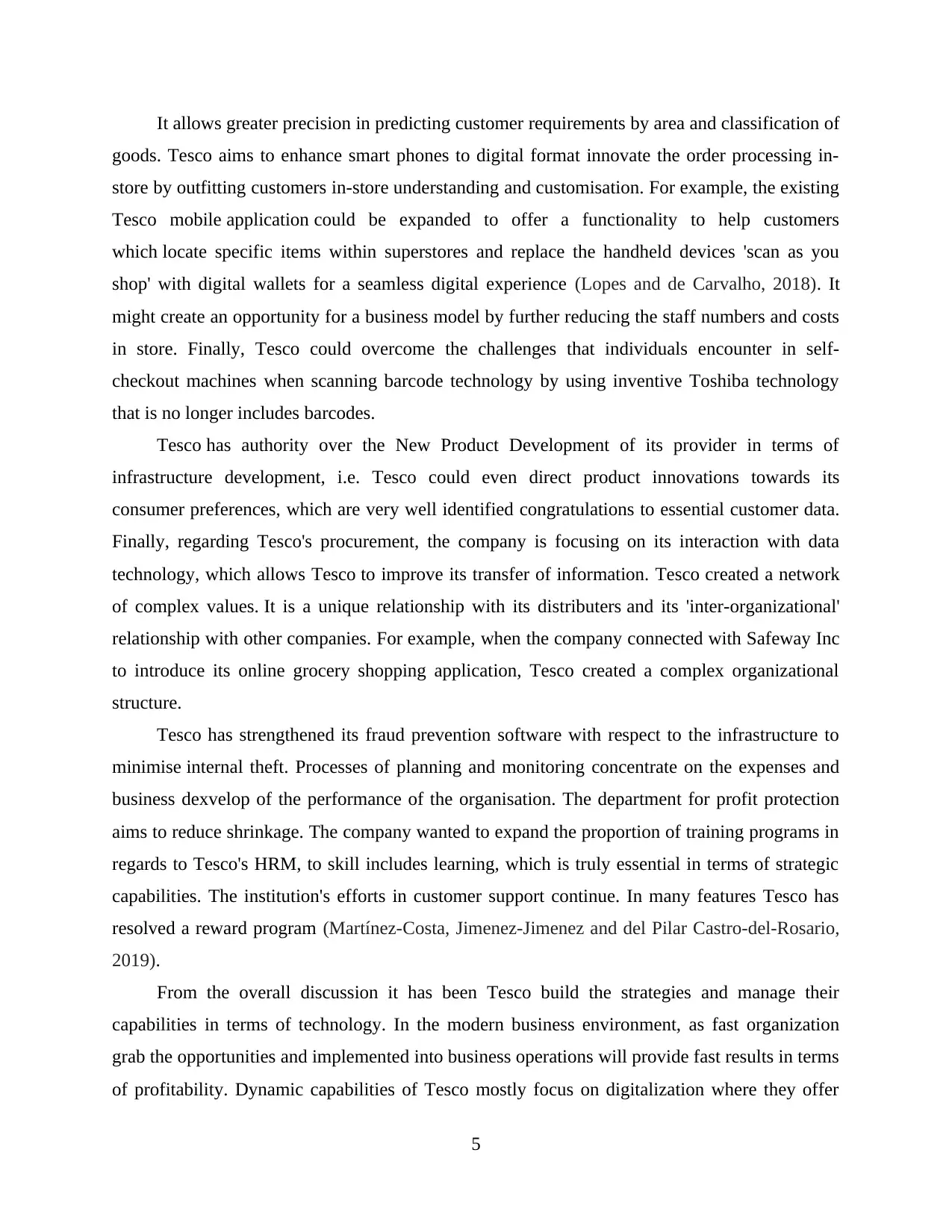
It allows greater precision in predicting customer requirements by area and classification of
goods. Tesco aims to enhance smart phones to digital format innovate the order processing in-
store by outfitting customers in-store understanding and customisation. For example, the existing
Tesco mobile application could be expanded to offer a functionality to help customers
which locate specific items within superstores and replace the handheld devices 'scan as you
shop' with digital wallets for a seamless digital experience (Lopes and de Carvalho, 2018). It
might create an opportunity for a business model by further reducing the staff numbers and costs
in store. Finally, Tesco could overcome the challenges that individuals encounter in self-
checkout machines when scanning barcode technology by using inventive Toshiba technology
that is no longer includes barcodes.
Tesco has authority over the New Product Development of its provider in terms of
infrastructure development, i.e. Tesco could even direct product innovations towards its
consumer preferences, which are very well identified congratulations to essential customer data.
Finally, regarding Tesco's procurement, the company is focusing on its interaction with data
technology, which allows Tesco to improve its transfer of information. Tesco created a network
of complex values. It is a unique relationship with its distributers and its 'inter-organizational'
relationship with other companies. For example, when the company connected with Safeway Inc
to introduce its online grocery shopping application, Tesco created a complex organizational
structure.
Tesco has strengthened its fraud prevention software with respect to the infrastructure to
minimise internal theft. Processes of planning and monitoring concentrate on the expenses and
business dexvelop of the performance of the organisation. The department for profit protection
aims to reduce shrinkage. The company wanted to expand the proportion of training programs in
regards to Tesco's HRM, to skill includes learning, which is truly essential in terms of strategic
capabilities. The institution's efforts in customer support continue. In many features Tesco has
resolved a reward program (Martínez-Costa, Jimenez-Jimenez and del Pilar Castro-del-Rosario,
2019).
From the overall discussion it has been Tesco build the strategies and manage their
capabilities in terms of technology. In the modern business environment, as fast organization
grab the opportunities and implemented into business operations will provide fast results in terms
of profitability. Dynamic capabilities of Tesco mostly focus on digitalization where they offer
5
goods. Tesco aims to enhance smart phones to digital format innovate the order processing in-
store by outfitting customers in-store understanding and customisation. For example, the existing
Tesco mobile application could be expanded to offer a functionality to help customers
which locate specific items within superstores and replace the handheld devices 'scan as you
shop' with digital wallets for a seamless digital experience (Lopes and de Carvalho, 2018). It
might create an opportunity for a business model by further reducing the staff numbers and costs
in store. Finally, Tesco could overcome the challenges that individuals encounter in self-
checkout machines when scanning barcode technology by using inventive Toshiba technology
that is no longer includes barcodes.
Tesco has authority over the New Product Development of its provider in terms of
infrastructure development, i.e. Tesco could even direct product innovations towards its
consumer preferences, which are very well identified congratulations to essential customer data.
Finally, regarding Tesco's procurement, the company is focusing on its interaction with data
technology, which allows Tesco to improve its transfer of information. Tesco created a network
of complex values. It is a unique relationship with its distributers and its 'inter-organizational'
relationship with other companies. For example, when the company connected with Safeway Inc
to introduce its online grocery shopping application, Tesco created a complex organizational
structure.
Tesco has strengthened its fraud prevention software with respect to the infrastructure to
minimise internal theft. Processes of planning and monitoring concentrate on the expenses and
business dexvelop of the performance of the organisation. The department for profit protection
aims to reduce shrinkage. The company wanted to expand the proportion of training programs in
regards to Tesco's HRM, to skill includes learning, which is truly essential in terms of strategic
capabilities. The institution's efforts in customer support continue. In many features Tesco has
resolved a reward program (Martínez-Costa, Jimenez-Jimenez and del Pilar Castro-del-Rosario,
2019).
From the overall discussion it has been Tesco build the strategies and manage their
capabilities in terms of technology. In the modern business environment, as fast organization
grab the opportunities and implemented into business operations will provide fast results in terms
of profitability. Dynamic capabilities of Tesco mostly focus on digitalization where they offer
5
Paraphrase This Document
Need a fresh take? Get an instant paraphrase of this document with our AI Paraphraser
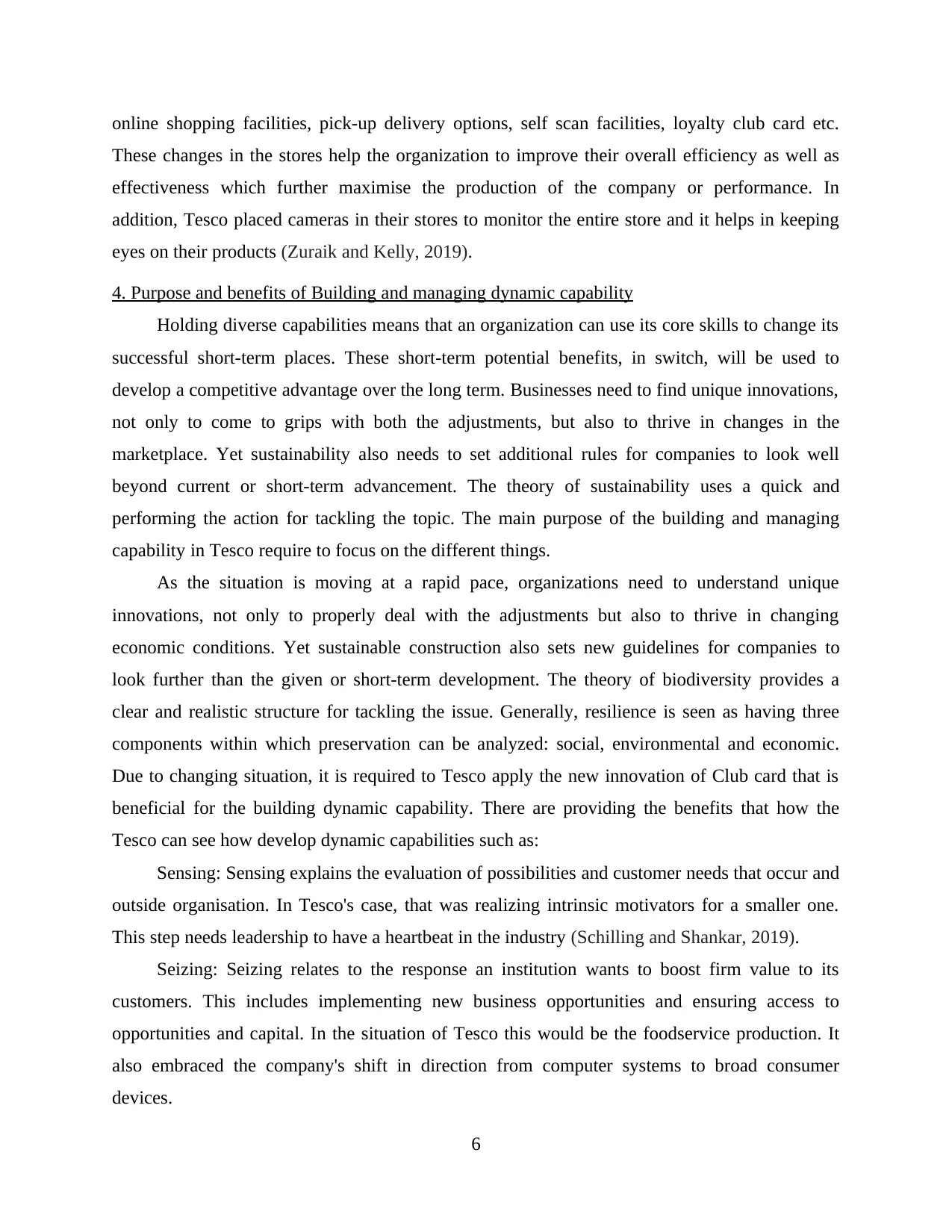
online shopping facilities, pick-up delivery options, self scan facilities, loyalty club card etc.
These changes in the stores help the organization to improve their overall efficiency as well as
effectiveness which further maximise the production of the company or performance. In
addition, Tesco placed cameras in their stores to monitor the entire store and it helps in keeping
eyes on their products (Zuraik and Kelly, 2019).
4. Purpose and benefits of Building and managing dynamic capability
Holding diverse capabilities means that an organization can use its core skills to change its
successful short-term places. These short-term potential benefits, in switch, will be used to
develop a competitive advantage over the long term. Businesses need to find unique innovations,
not only to come to grips with both the adjustments, but also to thrive in changes in the
marketplace. Yet sustainability also needs to set additional rules for companies to look well
beyond current or short-term advancement. The theory of sustainability uses a quick and
performing the action for tackling the topic. The main purpose of the building and managing
capability in Tesco require to focus on the different things.
As the situation is moving at a rapid pace, organizations need to understand unique
innovations, not only to properly deal with the adjustments but also to thrive in changing
economic conditions. Yet sustainable construction also sets new guidelines for companies to
look further than the given or short-term development. The theory of biodiversity provides a
clear and realistic structure for tackling the issue. Generally, resilience is seen as having three
components within which preservation can be analyzed: social, environmental and economic.
Due to changing situation, it is required to Tesco apply the new innovation of Club card that is
beneficial for the building dynamic capability. There are providing the benefits that how the
Tesco can see how develop dynamic capabilities such as:
Sensing: Sensing explains the evaluation of possibilities and customer needs that occur and
outside organisation. In Tesco's case, that was realizing intrinsic motivators for a smaller one.
This step needs leadership to have a heartbeat in the industry (Schilling and Shankar, 2019).
Seizing: Seizing relates to the response an institution wants to boost firm value to its
customers. This includes implementing new business opportunities and ensuring access to
opportunities and capital. In the situation of Tesco this would be the foodservice production. It
also embraced the company's shift in direction from computer systems to broad consumer
devices.
6
These changes in the stores help the organization to improve their overall efficiency as well as
effectiveness which further maximise the production of the company or performance. In
addition, Tesco placed cameras in their stores to monitor the entire store and it helps in keeping
eyes on their products (Zuraik and Kelly, 2019).
4. Purpose and benefits of Building and managing dynamic capability
Holding diverse capabilities means that an organization can use its core skills to change its
successful short-term places. These short-term potential benefits, in switch, will be used to
develop a competitive advantage over the long term. Businesses need to find unique innovations,
not only to come to grips with both the adjustments, but also to thrive in changes in the
marketplace. Yet sustainability also needs to set additional rules for companies to look well
beyond current or short-term advancement. The theory of sustainability uses a quick and
performing the action for tackling the topic. The main purpose of the building and managing
capability in Tesco require to focus on the different things.
As the situation is moving at a rapid pace, organizations need to understand unique
innovations, not only to properly deal with the adjustments but also to thrive in changing
economic conditions. Yet sustainable construction also sets new guidelines for companies to
look further than the given or short-term development. The theory of biodiversity provides a
clear and realistic structure for tackling the issue. Generally, resilience is seen as having three
components within which preservation can be analyzed: social, environmental and economic.
Due to changing situation, it is required to Tesco apply the new innovation of Club card that is
beneficial for the building dynamic capability. There are providing the benefits that how the
Tesco can see how develop dynamic capabilities such as:
Sensing: Sensing explains the evaluation of possibilities and customer needs that occur and
outside organisation. In Tesco's case, that was realizing intrinsic motivators for a smaller one.
This step needs leadership to have a heartbeat in the industry (Schilling and Shankar, 2019).
Seizing: Seizing relates to the response an institution wants to boost firm value to its
customers. This includes implementing new business opportunities and ensuring access to
opportunities and capital. In the situation of Tesco this would be the foodservice production. It
also embraced the company's shift in direction from computer systems to broad consumer
devices.
6
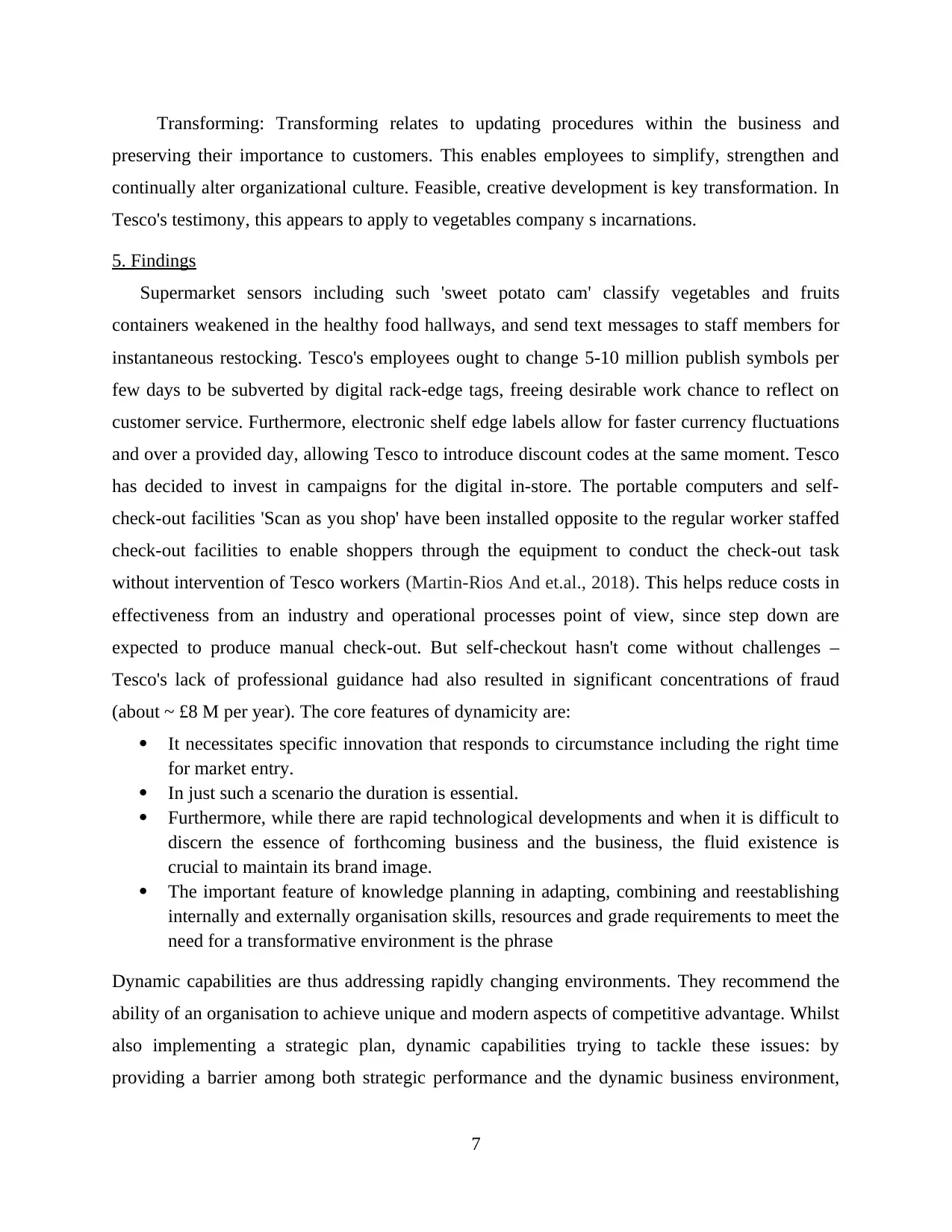
Transforming: Transforming relates to updating procedures within the business and
preserving their importance to customers. This enables employees to simplify, strengthen and
continually alter organizational culture. Feasible, creative development is key transformation. In
Tesco's testimony, this appears to apply to vegetables company s incarnations.
5. Findings
Supermarket sensors including such 'sweet potato cam' classify vegetables and fruits
containers weakened in the healthy food hallways, and send text messages to staff members for
instantaneous restocking. Tesco's employees ought to change 5-10 million publish symbols per
few days to be subverted by digital rack-edge tags, freeing desirable work chance to reflect on
customer service. Furthermore, electronic shelf edge labels allow for faster currency fluctuations
and over a provided day, allowing Tesco to introduce discount codes at the same moment. Tesco
has decided to invest in campaigns for the digital in-store. The portable computers and self-
check-out facilities 'Scan as you shop' have been installed opposite to the regular worker staffed
check-out facilities to enable shoppers through the equipment to conduct the check-out task
without intervention of Tesco workers (Martin-Rios And et.al., 2018). This helps reduce costs in
effectiveness from an industry and operational processes point of view, since step down are
expected to produce manual check-out. But self-checkout hasn't come without challenges –
Tesco's lack of professional guidance had also resulted in significant concentrations of fraud
(about ~ £8 M per year). The core features of dynamicity are:
It necessitates specific innovation that responds to circumstance including the right time
for market entry.
In just such a scenario the duration is essential.
Furthermore, while there are rapid technological developments and when it is difficult to
discern the essence of forthcoming business and the business, the fluid existence is
crucial to maintain its brand image.
The important feature of knowledge planning in adapting, combining and reestablishing
internally and externally organisation skills, resources and grade requirements to meet the
need for a transformative environment is the phrase
Dynamic capabilities are thus addressing rapidly changing environments. They recommend the
ability of an organisation to achieve unique and modern aspects of competitive advantage. Whilst
also implementing a strategic plan, dynamic capabilities trying to tackle these issues: by
providing a barrier among both strategic performance and the dynamic business environment,
7
preserving their importance to customers. This enables employees to simplify, strengthen and
continually alter organizational culture. Feasible, creative development is key transformation. In
Tesco's testimony, this appears to apply to vegetables company s incarnations.
5. Findings
Supermarket sensors including such 'sweet potato cam' classify vegetables and fruits
containers weakened in the healthy food hallways, and send text messages to staff members for
instantaneous restocking. Tesco's employees ought to change 5-10 million publish symbols per
few days to be subverted by digital rack-edge tags, freeing desirable work chance to reflect on
customer service. Furthermore, electronic shelf edge labels allow for faster currency fluctuations
and over a provided day, allowing Tesco to introduce discount codes at the same moment. Tesco
has decided to invest in campaigns for the digital in-store. The portable computers and self-
check-out facilities 'Scan as you shop' have been installed opposite to the regular worker staffed
check-out facilities to enable shoppers through the equipment to conduct the check-out task
without intervention of Tesco workers (Martin-Rios And et.al., 2018). This helps reduce costs in
effectiveness from an industry and operational processes point of view, since step down are
expected to produce manual check-out. But self-checkout hasn't come without challenges –
Tesco's lack of professional guidance had also resulted in significant concentrations of fraud
(about ~ £8 M per year). The core features of dynamicity are:
It necessitates specific innovation that responds to circumstance including the right time
for market entry.
In just such a scenario the duration is essential.
Furthermore, while there are rapid technological developments and when it is difficult to
discern the essence of forthcoming business and the business, the fluid existence is
crucial to maintain its brand image.
The important feature of knowledge planning in adapting, combining and reestablishing
internally and externally organisation skills, resources and grade requirements to meet the
need for a transformative environment is the phrase
Dynamic capabilities are thus addressing rapidly changing environments. They recommend the
ability of an organisation to achieve unique and modern aspects of competitive advantage. Whilst
also implementing a strategic plan, dynamic capabilities trying to tackle these issues: by
providing a barrier among both strategic performance and the dynamic business environment,
7
⊘ This is a preview!⊘
Do you want full access?
Subscribe today to unlock all pages.

Trusted by 1+ million students worldwide
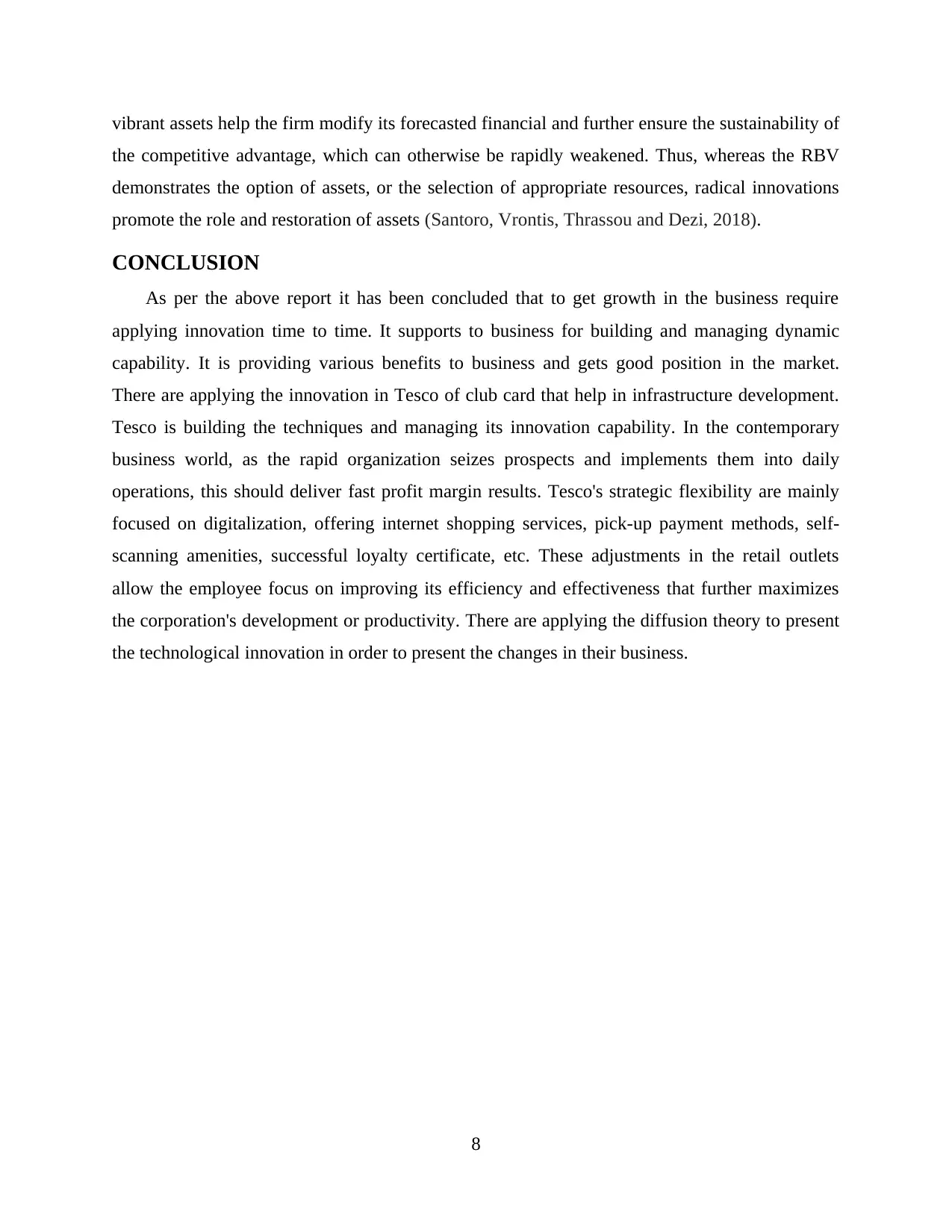
vibrant assets help the firm modify its forecasted financial and further ensure the sustainability of
the competitive advantage, which can otherwise be rapidly weakened. Thus, whereas the RBV
demonstrates the option of assets, or the selection of appropriate resources, radical innovations
promote the role and restoration of assets (Santoro, Vrontis, Thrassou and Dezi, 2018).
CONCLUSION
As per the above report it has been concluded that to get growth in the business require
applying innovation time to time. It supports to business for building and managing dynamic
capability. It is providing various benefits to business and gets good position in the market.
There are applying the innovation in Tesco of club card that help in infrastructure development.
Tesco is building the techniques and managing its innovation capability. In the contemporary
business world, as the rapid organization seizes prospects and implements them into daily
operations, this should deliver fast profit margin results. Tesco's strategic flexibility are mainly
focused on digitalization, offering internet shopping services, pick-up payment methods, self-
scanning amenities, successful loyalty certificate, etc. These adjustments in the retail outlets
allow the employee focus on improving its efficiency and effectiveness that further maximizes
the corporation's development or productivity. There are applying the diffusion theory to present
the technological innovation in order to present the changes in their business.
8
the competitive advantage, which can otherwise be rapidly weakened. Thus, whereas the RBV
demonstrates the option of assets, or the selection of appropriate resources, radical innovations
promote the role and restoration of assets (Santoro, Vrontis, Thrassou and Dezi, 2018).
CONCLUSION
As per the above report it has been concluded that to get growth in the business require
applying innovation time to time. It supports to business for building and managing dynamic
capability. It is providing various benefits to business and gets good position in the market.
There are applying the innovation in Tesco of club card that help in infrastructure development.
Tesco is building the techniques and managing its innovation capability. In the contemporary
business world, as the rapid organization seizes prospects and implements them into daily
operations, this should deliver fast profit margin results. Tesco's strategic flexibility are mainly
focused on digitalization, offering internet shopping services, pick-up payment methods, self-
scanning amenities, successful loyalty certificate, etc. These adjustments in the retail outlets
allow the employee focus on improving its efficiency and effectiveness that further maximizes
the corporation's development or productivity. There are applying the diffusion theory to present
the technological innovation in order to present the changes in their business.
8
Paraphrase This Document
Need a fresh take? Get an instant paraphrase of this document with our AI Paraphraser
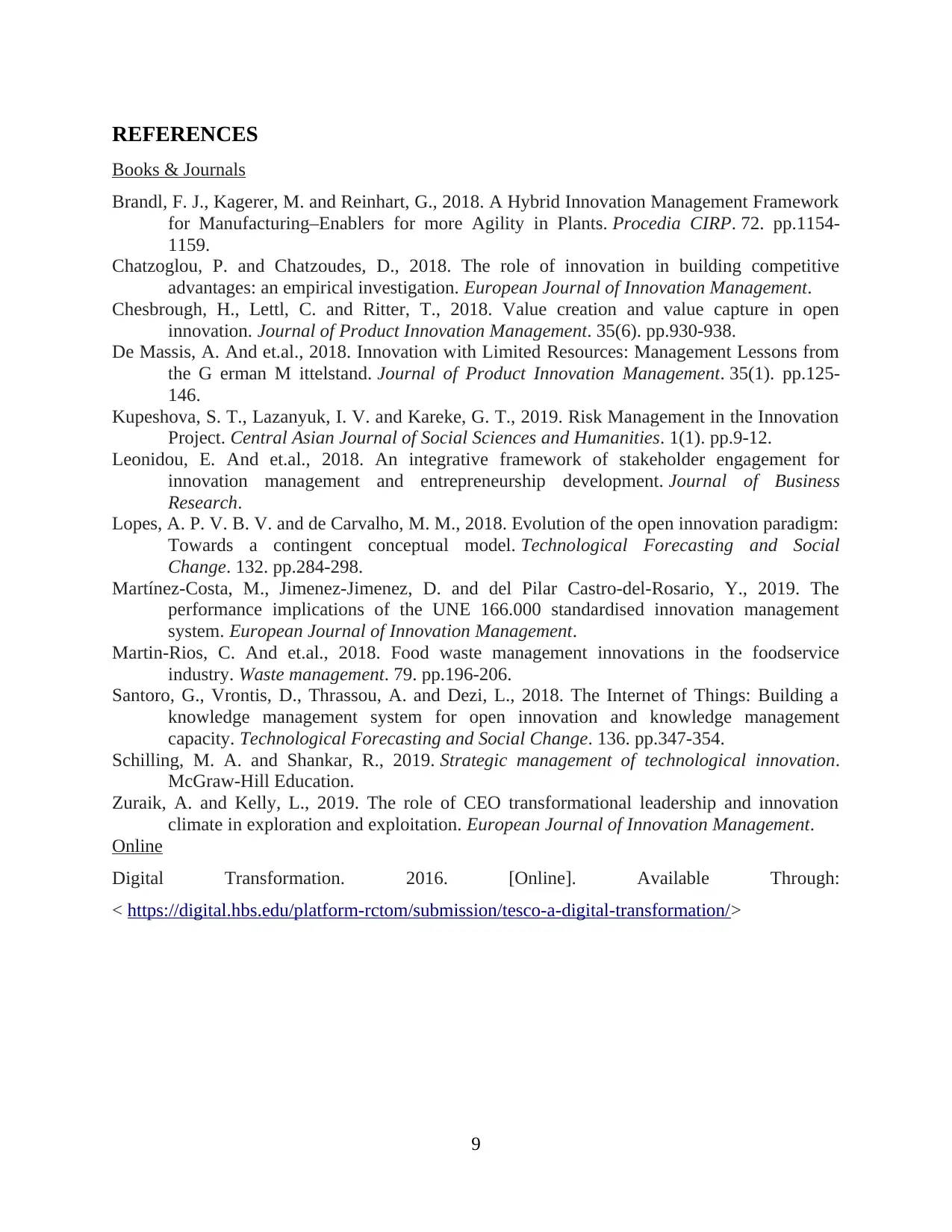
REFERENCES
Books & Journals
Brandl, F. J., Kagerer, M. and Reinhart, G., 2018. A Hybrid Innovation Management Framework
for Manufacturing–Enablers for more Agility in Plants. Procedia CIRP. 72. pp.1154-
1159.
Chatzoglou, P. and Chatzoudes, D., 2018. The role of innovation in building competitive
advantages: an empirical investigation. European Journal of Innovation Management.
Chesbrough, H., Lettl, C. and Ritter, T., 2018. Value creation and value capture in open
innovation. Journal of Product Innovation Management. 35(6). pp.930-938.
De Massis, A. And et.al., 2018. Innovation with Limited Resources: Management Lessons from
the G erman M ittelstand. Journal of Product Innovation Management. 35(1). pp.125-
146.
Kupeshova, S. T., Lazanyuk, I. V. and Kareke, G. T., 2019. Risk Management in the Innovation
Project. Central Asian Journal of Social Sciences and Humanities. 1(1). pp.9-12.
Leonidou, E. And et.al., 2018. An integrative framework of stakeholder engagement for
innovation management and entrepreneurship development. Journal of Business
Research.
Lopes, A. P. V. B. V. and de Carvalho, M. M., 2018. Evolution of the open innovation paradigm:
Towards a contingent conceptual model. Technological Forecasting and Social
Change. 132. pp.284-298.
Martínez-Costa, M., Jimenez-Jimenez, D. and del Pilar Castro-del-Rosario, Y., 2019. The
performance implications of the UNE 166.000 standardised innovation management
system. European Journal of Innovation Management.
Martin-Rios, C. And et.al., 2018. Food waste management innovations in the foodservice
industry. Waste management. 79. pp.196-206.
Santoro, G., Vrontis, D., Thrassou, A. and Dezi, L., 2018. The Internet of Things: Building a
knowledge management system for open innovation and knowledge management
capacity. Technological Forecasting and Social Change. 136. pp.347-354.
Schilling, M. A. and Shankar, R., 2019. Strategic management of technological innovation.
McGraw-Hill Education.
Zuraik, A. and Kelly, L., 2019. The role of CEO transformational leadership and innovation
climate in exploration and exploitation. European Journal of Innovation Management.
Online
Digital Transformation. 2016. [Online]. Available Through:
< https://digital.hbs.edu/platform-rctom/submission/tesco-a-digital-transformation/>
9
Books & Journals
Brandl, F. J., Kagerer, M. and Reinhart, G., 2018. A Hybrid Innovation Management Framework
for Manufacturing–Enablers for more Agility in Plants. Procedia CIRP. 72. pp.1154-
1159.
Chatzoglou, P. and Chatzoudes, D., 2018. The role of innovation in building competitive
advantages: an empirical investigation. European Journal of Innovation Management.
Chesbrough, H., Lettl, C. and Ritter, T., 2018. Value creation and value capture in open
innovation. Journal of Product Innovation Management. 35(6). pp.930-938.
De Massis, A. And et.al., 2018. Innovation with Limited Resources: Management Lessons from
the G erman M ittelstand. Journal of Product Innovation Management. 35(1). pp.125-
146.
Kupeshova, S. T., Lazanyuk, I. V. and Kareke, G. T., 2019. Risk Management in the Innovation
Project. Central Asian Journal of Social Sciences and Humanities. 1(1). pp.9-12.
Leonidou, E. And et.al., 2018. An integrative framework of stakeholder engagement for
innovation management and entrepreneurship development. Journal of Business
Research.
Lopes, A. P. V. B. V. and de Carvalho, M. M., 2018. Evolution of the open innovation paradigm:
Towards a contingent conceptual model. Technological Forecasting and Social
Change. 132. pp.284-298.
Martínez-Costa, M., Jimenez-Jimenez, D. and del Pilar Castro-del-Rosario, Y., 2019. The
performance implications of the UNE 166.000 standardised innovation management
system. European Journal of Innovation Management.
Martin-Rios, C. And et.al., 2018. Food waste management innovations in the foodservice
industry. Waste management. 79. pp.196-206.
Santoro, G., Vrontis, D., Thrassou, A. and Dezi, L., 2018. The Internet of Things: Building a
knowledge management system for open innovation and knowledge management
capacity. Technological Forecasting and Social Change. 136. pp.347-354.
Schilling, M. A. and Shankar, R., 2019. Strategic management of technological innovation.
McGraw-Hill Education.
Zuraik, A. and Kelly, L., 2019. The role of CEO transformational leadership and innovation
climate in exploration and exploitation. European Journal of Innovation Management.
Online
Digital Transformation. 2016. [Online]. Available Through:
< https://digital.hbs.edu/platform-rctom/submission/tesco-a-digital-transformation/>
9
1 out of 11
Related Documents
Your All-in-One AI-Powered Toolkit for Academic Success.
+13062052269
info@desklib.com
Available 24*7 on WhatsApp / Email
![[object Object]](/_next/static/media/star-bottom.7253800d.svg)
Unlock your academic potential
Copyright © 2020–2025 A2Z Services. All Rights Reserved. Developed and managed by ZUCOL.





